Astrology, Kriya Yoga, Dharma
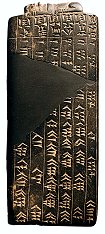
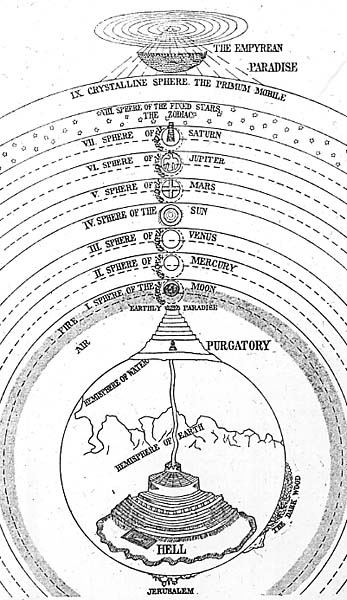 In his talks about Mythology, Joseph Campbell pointed
to a critical moment in human history when the residents of Bronze-Age Mesopotamia, the
fertile crescent, first developed the arts of agriculture and animal husbandry. This led to sustained
population growth, the appearance of cities and the division of labor - which allowed the eventual creation
of what
today we call "professions". Among these professions or castes was the priesthood, whose task it
was to observe and interpret the heavens. Even today, the line is blurred in English between the notion of
Heaven as
the home of the Creator and final resting place of virtuous souls - and "the heavens" or night sky. What
today we take as synonymous
with outer space, our ancestors took until quite recently as various celestial realms
above the earthly sphere, each of which they identified with a planet and its qualities.
In his talks about Mythology, Joseph Campbell pointed
to a critical moment in human history when the residents of Bronze-Age Mesopotamia, the
fertile crescent, first developed the arts of agriculture and animal husbandry. This led to sustained
population growth, the appearance of cities and the division of labor - which allowed the eventual creation
of what
today we call "professions". Among these professions or castes was the priesthood, whose task it
was to observe and interpret the heavens. Even today, the line is blurred in English between the notion of
Heaven as
the home of the Creator and final resting place of virtuous souls - and "the heavens" or night sky. What
today we take as synonymous
with outer space, our ancestors took until quite recently as various celestial realms
above the earthly sphere, each of which they identified with a planet and its qualities.
This basically ptolemaic model remained the officially accepted scientific view for ages, until Copernicus proposed his radically different Heliocentric view in the 16th Century. Campbell mentions that even Christopher Columbus followed the ptolemaic model of the Universe: Upon reaching a place in the ocean with abundant fresh water, Columbus wondered if his ships had reached the holy rivers which were believed to surround Paradise.
To the ancient Mesopotamians the fundamental discovery was that the heavens revolve in ever-repeating cycles, wheels within wheels, as described in the Book of Ezekiel. In this view, all the gods and deities serve as impersonal agents, bureaucrats of a revolving machine which relentlessly dispenses the will of Heaven.
An important role of the priesthood in this view was to discern the symbolic meaning of those cycles, to interpret them for the others, so that civilization might reach a state of harmony or accord with Divine Law. Hindu priests continue the practice to this day.
 On a practical level, observing
the regular motion of the stars and planets and the irregular motion of comets and other
visitors to our skies, promoted the correct timing of agriculture: planting, harvesting and the prediction
of weather, which even today, is called
"Meteorology".
On a practical level, observing
the regular motion of the stars and planets and the irregular motion of comets and other
visitors to our skies, promoted the correct timing of agriculture: planting, harvesting and the prediction
of weather, which even today, is called
"Meteorology".
Over time, it came to include the discovery of auspicious times for waging war, for marriage, for undertaking journeys, etc. Known as muhurtha in Sanskrit, it is called "Electional Astrology" in English. Muhurtha means, in this context, "moment". The classical Indian calendar divides the day into 18 segments, called muhurthas, which are 45 minutes long. The Hour or Hora came in with the Greeks.
In the Orthodox Hindu tradition, the planets are the deliverers of Karma to each individual at birth. The ever-spinning celestial configurations are seen as the engine of Fate, impersonal and unshakeable. Their effects can be softened through good deeds and rituals of intercession, but never fully erased. The planets are respected, even revered and propitiated, as divine individuals in their own right, for they are the celestial agents who dispense the Karma Phalam or fruits of action. Composed in the early 4th Century CE by Minaraja, an early Indian Astrology text called Vriddhayavanajataka expresses this sentiment as follows: (translation courtesy of Dr. Martin Gansten)
"Even as a lamp reveals objects in utter darkness,
this science reveals the fate which,
carrying the impact of previous action,
was inscribed on Man's forehead by the Creator."
 Today, some priests wear a
special collar around the neck:
the place in the body which stands between the "higher" impulses of the Spirit in the head and the "lower"
urges of
the Flesh below. Called the Mercury
Chakra
in Kriya Yoga because of its correspondence with the fastest-moving planet closest to the Sun, it
represents the mystical level of Hermes,
the winged Greek God who guided souls to the underworld and brought messages from the Gods to Mankind.
Mercury is the archetypal herald, who announces the Benediction or Gospel (literally "good
news") to the world from
on high. On an esoteric level, Mercury has rulership over the constellations Gemini and
Virgo. As
Gemini (the Twins) it expresses Vichara, mental curiosity and objective Inquiry. As Virgo (the
Virgin), it expresses that portion of our mind, which, when we attain a certain level of evolution,
brings Viveka (Discernment). Discrimination between the wholesome and the unwholesome, leads to
self-discipline and
control over the senses. Hence, the Sanskrit name of the throat chakra is Vishuddha: spiritual
purification.
Today, some priests wear a
special collar around the neck:
the place in the body which stands between the "higher" impulses of the Spirit in the head and the "lower"
urges of
the Flesh below. Called the Mercury
Chakra
in Kriya Yoga because of its correspondence with the fastest-moving planet closest to the Sun, it
represents the mystical level of Hermes,
the winged Greek God who guided souls to the underworld and brought messages from the Gods to Mankind.
Mercury is the archetypal herald, who announces the Benediction or Gospel (literally "good
news") to the world from
on high. On an esoteric level, Mercury has rulership over the constellations Gemini and
Virgo. As
Gemini (the Twins) it expresses Vichara, mental curiosity and objective Inquiry. As Virgo (the
Virgin), it expresses that portion of our mind, which, when we attain a certain level of evolution,
brings Viveka (Discernment). Discrimination between the wholesome and the unwholesome, leads to
self-discipline and
control over the senses. Hence, the Sanskrit name of the throat chakra is Vishuddha: spiritual
purification.
 Hindu Brahmins are considered
"twice born", by virtue of
their birth into an upper caste and participation in the Upanayanam
or
sacred thread ceremony at age 12. The second birth signals the attainment of higher spiritual awareness,
and coincides with the first return of planet Jupiter to its
natal position in the horoscope. At this point, Jupiter facilitates the soul's unfoldment -
a movement beyond the merely biological existence of eating, drinking and sleeping. Jupiter's traditional
association is
with higher knowledge and higher education. One of its Sanskrit names is Guru, the teacher. At the
age of twelve - having attained a stable
physical body and requisite intelligence - Brahmin priests begin in earnest their formal study of the Vedas, which instruct them in how to dispense the
Grace of Heaven through recitation of the sacred Word, or Mantram.
Hindu Brahmins are considered
"twice born", by virtue of
their birth into an upper caste and participation in the Upanayanam
or
sacred thread ceremony at age 12. The second birth signals the attainment of higher spiritual awareness,
and coincides with the first return of planet Jupiter to its
natal position in the horoscope. At this point, Jupiter facilitates the soul's unfoldment -
a movement beyond the merely biological existence of eating, drinking and sleeping. Jupiter's traditional
association is
with higher knowledge and higher education. One of its Sanskrit names is Guru, the teacher. At the
age of twelve - having attained a stable
physical body and requisite intelligence - Brahmin priests begin in earnest their formal study of the Vedas, which instruct them in how to dispense the
Grace of Heaven through recitation of the sacred Word, or Mantram.
Those Christian ministers who today wear the collar, function in like manner: having been born again in Christ, they have experienced their own symbolic Virgin Birth. This is a transformation beyond the body and its concerns, to closer union with God, the essence of Being, which is eternal. It is a psychological birth, a spiritual experience. After such a birth, the mystic knower or Gnostic can rightly declare, "I and my Father are One".
Knowledge of this Oneness is the real bene dictus, or good word. The direct experience of one's own immortality is the real gud spiel ("good news"), the Gospel. Faith in the promise of Eternal Life, is confidence in the notion that eventually, we all awaken to our own divinity and discover that we are and have always been, immortal.
We might say that the ancient priestly caste were the scientists of their day. To these ancients, the orderliness of Nature - seen through the inexorable cycles of the heavens - was taken as evidence of Divine Perfection. Thus, the interpretation of "signs and portents" from Heaven was a job best suited to trained professionals of good character, as it remains today.
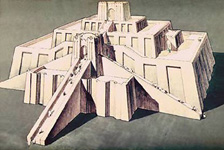 We can just imagine the Babylonians standing on their Ziggurat,
a giant observatory platform, constructed as a model of the Universe. Composed of stages, like the
wheels within wheels seen above, the different levels were symbolic of the levels of creation and the
corresponding planets. From atop the Zigurrat, they observed and measured the night skies with their
naked eyes, tracking the movements of the 5 wanderers, the five visible planets: Mercury, Venus, Mars,
Jupiter and Saturn - and the 2 lights: the Sun and the Moon. (see the Parable of the Five Loaves and Two
Fishes). We owe our seven-day week to the Babylonians and it was they who named the days after the
seven celestial orbs.
We can just imagine the Babylonians standing on their Ziggurat,
a giant observatory platform, constructed as a model of the Universe. Composed of stages, like the
wheels within wheels seen above, the different levels were symbolic of the levels of creation and the
corresponding planets. From atop the Zigurrat, they observed and measured the night skies with their
naked eyes, tracking the movements of the 5 wanderers, the five visible planets: Mercury, Venus, Mars,
Jupiter and Saturn - and the 2 lights: the Sun and the Moon. (see the Parable of the Five Loaves and Two
Fishes). We owe our seven-day week to the Babylonians and it was they who named the days after the
seven celestial orbs.
The telescope had not been invented, so they observed by the naked eye. Although they may not have understood the physics behind the precession of the equinoxes, the Babylonian astronomer/priests periodically updated their planetary tables, to account for its effect: a gradual backwards shifting of the seasons with respect to the stars. More on that later - much more.
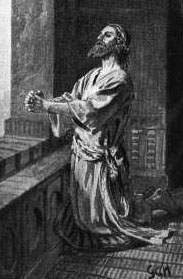
 Professor
Campbell often divided religions into two categories: those with a Creator standing
apart from Creation and those where the Creator is the creation. The first
category
includes the 3 main religions of the Levant or Middle-East: Judaism, Christianity and Islam. In the
second group, he placed those religions found west of Iran, such as Hinduism, Taoism and Buddhism.
Professor
Campbell often divided religions into two categories: those with a Creator standing
apart from Creation and those where the Creator is the creation. The first
category
includes the 3 main religions of the Levant or Middle-East: Judaism, Christianity and Islam. In the
second group, he placed those religions found west of Iran, such as Hinduism, Taoism and Buddhism.
In the first group, Man is a created being. All of Nature is a creation of God, dust as it were, into which the Lord has breathed Life. When Man looks within, he finds nothing divine, just more... dust. The mission of these religions, is to help the created individual establish and maintain a proper relationship with the Creator. Right relationship is defined as membership and participation in God's holy society. In Orthodox Judaism, it takes a minyan of 10 men to worship properly; in Catholicism, attending Church and receiving the sacraments; in Islam, fulfilling the Five Pillars of the Faith.
In the second group, everything is Divine. There is nothing outside. Everything is Holiness. According to this basically pantheistic view, every individual has Divinity at their core of being. The role of such religions is to assist the individual towards a deeper identity with their inherent Divinity. Joseph Campbell often refers to these two groups as Religions of Relationship and Religions of Identity. While religions of Relationship have a revealed text or scripture, religions of Identity find the Law revealed everywhere.
From the mystical perspective, Relationship and Identity are two sides of the same coin. They are two approaches to the same problem. In Sanskrit, they are called Saguna Brahman and Nirguna Brahman: Reality with Form and Reality Without Form. Reality is both immanent and transcendent. We can't have one without the other. There can only be something formless, if there are things with form. Something can only have an interior, if it has an exterior. The two arise together. In Buddhism, this is called Pratitya Samutpada: "Mutual Arising". Bliss is to be found, via the Middle Way: at the balance of extremes.
The notion that man can reach accord with Ultimate Reality is expressed in the East, through the Sanskrit term Dharma, which comes from the root word Dhr, meaning "to sustain". It has many meanings, but here, we could translate it as righteousness or being in-the-right. When we follow our Dharma, we are held, supported by, in harmony with the Universe. In Chinese, this principle is called the Dao or "Way". As it is written in the Dao De Jing:
"Man follows the Earth.
The Earth follows Heaven.
Heaven follows the Dao.
The Dao follows what is Natural."
According to religions of Relationship, the Universe was created from without, much as an engineer might devise a machine. It was made. In Chinese, the Universe exhibits the principle of Wu Wei, literally not made, not contrived. It simply unfolds and evolves, out of its own potential. The same quality is admired in mature individuals: they act out of freshness and spontaneity. Their creativity is unrehearsed and genuine. According to Alan Watts, it would never occur to a Daoist to ask how the Universe was "made". To such a question, God might reply sheepishly "Oh, that ? I have no special method."
Since the unfoldment of heavenly cycles was taken as the ultimate expression of divine will, Astrological thinking became a coordinating principle in classical Chinese architecture, statecraft, urban planning, the arts, medicine, etc. Important cities such as Beijing were laid out according to heavenly models. The Chinese Emperor's food, dress, diet and habits - even his physical location - were made to accord with a system based on the 5 visible planets. See Echoes of the Ancient Skies by E.C Krupp and Horst Hartung and Early Man and the Cosmos by Evan Hadingham.
Ancient Egyptian tombs and pyramids, we have recently learned, were laid out as a miniature map of certain regions of the night sky: Heaven on Earth, or rather, the Heavens on Earth. Archaeoastronomers continue to uncover the surprising lengths to which the ancients strived, to track and follow the sky, to remain in a state of Harmony or Grace.
The great circle of Stonehenge may have been used in the Bronze Age, not merely as a mundane calendar or observatory, but to synchronize the commencement of rituals, whose aim it was to invoke the blessings of Heaven for the good of society. Even today, when you go to a Hindu Temple and ask for a blessing from the priest, the priest asks you for your Jamna Nakshatra: the constellation, at the moment of your birth, where an observer would see the Moon. Marriages are performed only when the Moon passes through certain auspicious lunar mansions. The ground is to be broken, foundations are to be poured, journeys undertaken and hair cut - according to the same set of rules.
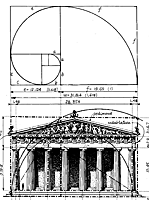
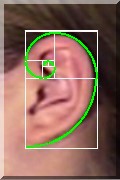 The
notion of
sacred architecture, sacred geometry - Feng Shui - emerge from the all-consuming Bronze
Age impulse: "As above, so below". Chinese official music was composed in accord with the divine proportions
and
ratios. Western music, based on the well-tempered scale introduced at the time of Bach, also reflects an
Astrological pattern: 12 notes to match the 12 months, 12 tribes, 12 labors of Hercules, 12
constellations, 12 major Acupuncture meridians, etc.
The
notion of
sacred architecture, sacred geometry - Feng Shui - emerge from the all-consuming Bronze
Age impulse: "As above, so below". Chinese official music was composed in accord with the divine proportions
and
ratios. Western music, based on the well-tempered scale introduced at the time of Bach, also reflects an
Astrological pattern: 12 notes to match the 12 months, 12 tribes, 12 labors of Hercules, 12
constellations, 12 major Acupuncture meridians, etc.
Just as we might find it unpleasant to have Pizza for breakfast, classical Indian Ragas or melodies are played only at their appropriate time of day or season. In Sanskrit, the word which describes this all is Rta, (pronounced like "ritta") from which descends our modern English word "rhythm".
There is a rhythm to life. Follow it and find bliss.
The Tropical zodiac is so-called because it is based on the apparent yearly motion of the Sun, northwards to the Tropic of Cancer, then southwards to the Tropic of Capricorn. The area between these two extremes we call "the tropics" and because the Sun never goes any further north or south, this belt around the equator stays rather warm throughout the year: hence the terms "tropical heat", "tropical storm", "tropical paradise", etc. Tropic comes from the Greek tropikos ("turning").
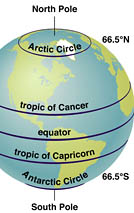
 As we all
know, Summer time
above the equator coincides with Winter time below the equator. When residents of Chile are basking in
the warmth of the Summer Sun, the gringos in el Norte are trudging through snow and sleet.
(Gringo is a mildly pejorative term used by Spanish-speakers of Central and South America, to
refer to their English-speaking friends to the north. It comes from the Spanish word griegos,
meaning Greek-speakers, IE those who utter an unintelligible tongue, e.g. not Spanish)
As we all
know, Summer time
above the equator coincides with Winter time below the equator. When residents of Chile are basking in
the warmth of the Summer Sun, the gringos in el Norte are trudging through snow and sleet.
(Gringo is a mildly pejorative term used by Spanish-speakers of Central and South America, to
refer to their English-speaking friends to the north. It comes from the Spanish word griegos,
meaning Greek-speakers, IE those who utter an unintelligible tongue, e.g. not Spanish)
So when Hipparchus (a real Gringo or Greek) suggested the notion of a fixed zodiac - an Astrology tied to the seasons, it only made sense for people living north of the equator - like the Greeks themselves.
The constellation Cancer is not, in fact, a summer sign... if you live in Australia, New Zealand, much of South America, Polynesia: anywhere south of the equator. Such a zodiac is off by 12,000 years, or 180 degrees of precession. Moreover, the summer and winter solstices mark the middle, or climax of their seasons, not the beginnings, as we take it today... but more on this later, when we take up the subject of Domification - the construction of houses.
The Babylonians seem to have been aware of precession and updated their almanacs on a regular basis - but told the Greeks nothing about it. The Greeks eventually discovered it, several centuries after taking up the craft.
Cyril Fagan, in his 1950 masterpiece Zodiacs Old And New, details the calculations employed in ancient Greek horoscopes and even older Babylonian epheremides and star catalogs. According to Cyril Fagan, a Babylonian ephemeris from the 6th Century BC lists the position of the vernal equinox at 12 degrees Aries. At that time, Cleostratus of Tenedos introduced the Babylonian Zodiac to the Greeks. Fagan goes on:
In the year 139 BC, Hipparchus discovered the phenomenon of precession, while comparing the observed position of Spica or Alpha Virginis against the one recorded 154 years earlier by Timocharis. What today we call the Tropical Zodiac, was invented - by accident when Hipparchus wrongly proposed that the vernal point be established, for all time, as 0 Aries - even though he knew that it was shifting slowly backwards. His 0 Aries zodiac was promptly rejected by astronomers of the day.
Manilius, the Roman astrologer during the reigns of Augustus and Tiberius, wrote
Columella, in 60 AD, wrote
In the 3rd Century AD, Achilles Tatius observed:
In 238 A.D. Censorius made a similar observation, promoting the Hellenistic zodiac, based on the 8th degree of Aries... and the list goes on. It's remarkable that even back then, Astrology was considered ancient and people were reluctant to take up anything new and unproven.
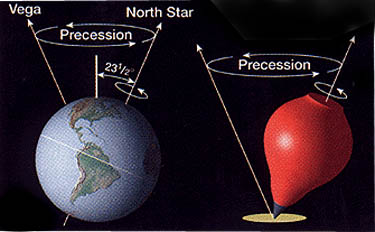 Fagan demonstrates that in these charts, the fiducial point, or ayanamsha, changes over time,
following the rate of precession and is fairly consistent. Over the centuries, ancient astrologers,
using direct observation, noted the positions of the planets, relative to the stars.
Fagan demonstrates that in these charts, the fiducial point, or ayanamsha, changes over time,
following the rate of precession and is fairly consistent. Over the centuries, ancient astrologers,
using direct observation, noted the positions of the planets, relative to the stars.
Nowhere in the charts, prior to Hipparchus, is there any mention of an adjustment made, with respect to the position of the vernal point in the northern hemisphere. They simply reported what they saw - something which changes 1 degree every 72 years. Earlier observers found the vernal point at 12 Aries, and a few hundred years later, observers found it at 8 Aries.
In other words, nowhere in these early horoscopes are Tropical positions derived or described: only the actual or apparent positions are used. These calculations are invariably based on the sidereal or star-based zodiac, whose origin is lost in the sands of antiquity. Fagan cites the 1947 work Babylonianische Planetenrechnum Eudemus, written by Van der Waerden and another by Professor Otto Neugerbauer, which discuss a series of Egyptian planetary texts, written on papyrus, in which the vernal point changes according to the date of the document: 4 degrees of Aries from 17 BC to 11 AD, 2 degrees Aries from 71 to 132 AD, etc.
The early Greeks, when it came to the notion of precession, were apparently left in the dark by their Egyptian and Babylonian tutors - who may have been reluctant to share all their secrets, gathered over aeons of careful observation. Not knowing that the equinoxes move backwards slowly over time, certain Greeks wrongly supposed that the equinoxes were frozen in Sphere VIII - the Realm of the Fixed Stars. When Hipparchus proposed 0 Aries, as if to resolve the dispute, his mistaken notion was picked up by Ptolemy, whose books endured, while the original texts fell out of print.
By the time Astrology was reintroduced into Europe, the blunder was over 1,000 years old: the Tropical Zodiac was off by over 15 degrees, more than half a sign. Astrologers of the European tradition have been afflicted by this colossal error, ever since. In tradition-upholding India, this accident never happened: the original nirayana (sidereal) tradition - which goes back to the Babylonians and Egyptians - was maintained intact.
A truly outstanding summary of European confusion over the sidereal and tropical zodiacs appeared in Western Sidereal Astrology: An Interview with Kenneth Bowser in the October/November 2004 issue of The Mountain Astrologer Magazine.
According to Fagan, ancient astronomers used several "normal" stars to frame the zodiac: these stars are very bright, found near the equator and move very slowly over time. Regulus, the Heart of the Lion, marked 5 degrees Leo. Antares (the "rival of Mars") marks 15 degrees of Scorpio and the Pleiades marked 5 degrees of Taurus. Perhaps the most important is Alpha Tauri or Aldebaran, which marked the "bull's eye" at 15 degrees of Taurus. Its Arabic name al dabaran means "the follower": it follows the Pleiades, whose Japanese name is Subaru.

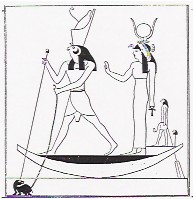 Another
star of vital
interest to the ancients, is Alpha Virginis, called Spica by European astronomers. It is the
brightest star in the
constellation Virgo. Virgo is the none other than the
old
Egyptian goddess Isis, the Divine Mother, who corresponds to the Virgin Mary. As Mother of God, she
holds the baby Jesus
on her lap. Goddess of the Harvest, she was known as Ceres
to the Romans.
Ceres held a sheaf or spike of grain or cereal in her hand: hence the name Spica
Another
star of vital
interest to the ancients, is Alpha Virginis, called Spica by European astronomers. It is the
brightest star in the
constellation Virgo. Virgo is the none other than the
old
Egyptian goddess Isis, the Divine Mother, who corresponds to the Virgin Mary. As Mother of God, she
holds the baby Jesus
on her lap. Goddess of the Harvest, she was known as Ceres
to the Romans.
Ceres held a sheaf or spike of grain or cereal in her hand: hence the name Spica
The Egyptian name for Spica is mnit or Menyet. It means "mooring peg" - from the root mn or Men, meaning "to rest", "to be secure", "to be immovable" as in death. The Egyptians referred to the West as Amentet, the place of death or final rest, the hidden place and the portal to the Underworld.
The boats of the planetary gods, having crossed the Nile in the Skies (as above, so below), came to rest at the end of the zodiac. Thus, Fagan suggests that Spica indicates the end of the cycle, the 29th degree of the constellation Virgo. It is called Alpha Virginis, because it is the brightest star in that constellation. Fagan points out that once we place Spica at 29 Virgo, the "normal" stars fall exactly in their rightful places and the Bull's Eye hits the "Bull's Eye" precisely. This is a compelling argument, but is Mother Nature always that tidy ?
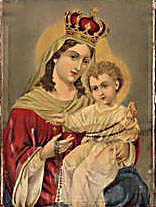 The Sanskrit name for
Spica is Chitraa ("the pearl").
Cyril Fagan proposed that while the Indian Siddhanta texts
use the longitude of Spica to denote 0 Libra, the Egyptians considered it to mark the end of
their Zodiac, the 29th or final degree of Virgo. In contrast to this Indian zodiac, Fagan called the
Babylonian and
Egyptian version the "Hypsomatic" zodiac. That was his interpretation, which has been subsequently
challenged.
The Sanskrit name for
Spica is Chitraa ("the pearl").
Cyril Fagan proposed that while the Indian Siddhanta texts
use the longitude of Spica to denote 0 Libra, the Egyptians considered it to mark the end of
their Zodiac, the 29th or final degree of Virgo. In contrast to this Indian zodiac, Fagan called the
Babylonian and
Egyptian version the "Hypsomatic" zodiac. That was his interpretation, which has been subsequently
challenged.
Actually, the ancient Egyptians used several calendars: some for civil purposes, others for ceremonial undertakings. Their reliance on the heliacal rising of Sirius, the "dog star" of summer, is well-known. For the laying out of their temples, as far back as the 3rd millennium BC, they used another calendar, referred to as "The Calendar of the Ancients" - which was based on... Spica!
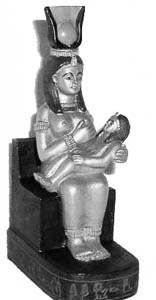 If the Egyptians called it
"ancient" back in 3000 BC, it must have been very ancient !
The Calendar of the Ancients is based on Spica, or Alpha Virginis. In that calendar,
Spica may mark not the end of Virgo, but
the beginning of Libra. A difference of 1 degree: doesn't sound like much, until you use a
technique
which requires exact timing and positions. In that case, your predictions might be off by a year, or
even more, depending on the method in question. For those born "on the cusp", or with planets at the end
of beginning of a sign, it also has a meaning: is the planet in "old age" (late degree), or "infant
stage" (early degree) or is it really at 0 degrees of its sign ? Since the strength of a planet is
influenced by its positional strength or Sthana Bala, the difference of one degree can tell us a lot.
If the Egyptians called it
"ancient" back in 3000 BC, it must have been very ancient !
The Calendar of the Ancients is based on Spica, or Alpha Virginis. In that calendar,
Spica may mark not the end of Virgo, but
the beginning of Libra. A difference of 1 degree: doesn't sound like much, until you use a
technique
which requires exact timing and positions. In that case, your predictions might be off by a year, or
even more, depending on the method in question. For those born "on the cusp", or with planets at the end
of beginning of a sign, it also has a meaning: is the planet in "old age" (late degree), or "infant
stage" (early degree) or is it really at 0 degrees of its sign ? Since the strength of a planet is
influenced by its positional strength or Sthana Bala, the difference of one degree can tell us a lot.
So which ayanamsha is right: Fagan's proposed Egyptian/Babylonian Hypsomatic one - or the Indian ? Most Indian astrologers prefer the Spica zodiac, called the Chitraa Paksha Ayanamsha and it's the official ayanamsha of the Indian Government, used throughout the country for the coordination of holidays and festivals - many of which are based on heavenly cycles.
Before there was a standard, different regions around the nation published their own almanacs, each with its own variation on the calculation of the ayanamsha - and this resulted in conflicts and confusion concerning dates and times for religious activities. After Indian independence in 1947, a special council of scientists and experts and was convened to make this determination, chaired by N.C Lahiri. His name has been associated with the official ayanamsha ever since and remains the most popular: it is called the Lahiri Ayanamsha.
In 285 CE - the year singled out by the Lahiri Ayanamsha - Emperor Diocletian divided the Roman Empire into two parts: the Western and Eastern Roman Empires. We might consider 285 AD as the beginning of the end of the Roman Empire. It has grown too large to efficiently govern and would eventually be broken up and overrun.
This series of articles uses the Lahiri ayanamsha, where Spica denotes 0 degrees Libra, but have a look at Meanderings 6 where the Krishnamurthi Ayanamsha proves its merit in the horoscope of Agatha Christie.
Astronomers have discovered that Spica is in fact a binary star. How appropriate as primary symbol for Libra - the Scales - a dual symbol par excellence!
Speaking of precise calculations, one of the most popular methods in Indian Astrology for determining future events, depends on the exact zodiacal longitude of the Moon. In fact, the position of the Moon is the sole ingredient needed to calculate the Vimshottari Dasha, or 120-year cycle, which we will discuss shortly.
 When the ancients measured the stars
and the planets, they did so at night - and the Moon was their
principle timekeeper. For that reason, the ancient calendars are Lunar and start in the Autumn rather
than the Spring. For the same reason, the Jewish Sabbath commences at sun set, rather than
sun-rise.
When the ancients measured the stars
and the planets, they did so at night - and the Moon was their
principle timekeeper. For that reason, the ancient calendars are Lunar and start in the Autumn rather
than the Spring. For the same reason, the Jewish Sabbath commences at sun set, rather than
sun-rise.
Sunset is when the first stars come up over the Eastern horizon, as the Sun sets in the west. To the ancients, the year started when the stars of Aries became visible, not when the Sun entered Aries. Again, the later Greeks and the Europeans who followed them... got it backwards.
Because we can't see any stars during the day, it's hard for a sky-watcher to observe the position of the Sun or any of the heavenly bodies. That's one practical reason why the old calendars are Lunar, and the really ancient calendars are... Stellar ! Much of the ancient knowledge that is lost to us today, may have to do with the influences and meanings of the stars. (The Edgar Cayce readings cover some of this information: see Chapter 15).
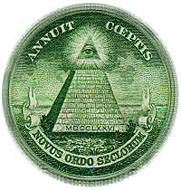 According to many experts, the Tropical and Sidereal zodiacs were coincident somewhere around the 3rd
century A.D. After that date, the Vernal Equinox occurred in the constellation of the Fishes and
following ancient tradition, the Egyptians assigned a new zodiacal era, the Age of Pisces, to the next
2000-year segment of time, in what astronomers today call the Platonic
Year.
According to many experts, the Tropical and Sidereal zodiacs were coincident somewhere around the 3rd
century A.D. After that date, the Vernal Equinox occurred in the constellation of the Fishes and
following ancient tradition, the Egyptians assigned a new zodiacal era, the Age of Pisces, to the next
2000-year segment of time, in what astronomers today call the Platonic
Year.
As the Vernal Equinox recedes slowly through the constellations, a new world cycle commences every 25,800 years: a veritable Novus Ordo Seclorum, or "New Order of Ages". During the Age of Pisces, the followers of this tradition changed their symbols of divinity from the Ram (Aries) to the Fish (Pisces), from a Fire symbol to a Water symbol. At the transition, the Roman Empire was overrun and was eventually replaced with the Holy Roman Empire and the Church of Rome. Conquest and exploration were determined by naval power (and later oil power), while knowledge and religion were maintained by monks in secluded contemplation - in Christendom anyhow.
There are twelve divisions to this ancient Egyptian cycle and a new "Age" comes along when the Vernal Point slips backwards into a new constellation. Like the rest of traditional astrological reasoning, it's a purely Sidereal notion, based on the stars and not the seasons. From a Tropical viewpoint, the Vernal Equinox always denotes 0 Aries and the stars are, as it were, irrelevant.
From a strictly Tropical perspective, there is no such cycle of ages, but the star-oriented Egyptians followed it relentlessly, at least as far back as the Age of Gemini, the Twins - from roughly 6000 BC to 4000 BC - during which time the land was divided into two states: Upper and Lower Egypt. Each state had its own capital city. In fact, each capital was itself, a twin city. They took the symbolism very seriously !
 Some
would hold that the Age of the Fishes coincided with the birth
of the Fisher of Men. Others would point out that it took several hundred years for his
Church to
be fully established, during which time his followers were persecuted and were forced to worship in
hiding, as they were considered Pagans by the priests of Rome.
Some
would hold that the Age of the Fishes coincided with the birth
of the Fisher of Men. Others would point out that it took several hundred years for his
Church to
be fully established, during which time his followers were persecuted and were forced to worship in
hiding, as they were considered Pagans by the priests of Rome.
 When exactly did the Age of
Pisces really start ? Was it
in 325 A.D. when the First Council of
Nicea met and established a unified system of beliefs ? Was it earlier, in 313 A.D., when Constantine
the Great issued the Edict of Milan
establishing Christianity as the official religion of the Roman Empire ?
When exactly did the Age of
Pisces really start ? Was it
in 325 A.D. when the First Council of
Nicea met and established a unified system of beliefs ? Was it earlier, in 313 A.D., when Constantine
the Great issued the Edict of Milan
establishing Christianity as the official religion of the Roman Empire ?
Perhaps it was still earlier, in 285 A.D., which is what we find when we simply follow the Astronomy. Since we know the current position of Spica and that precession occurs at a precisely calculable rate, we perform some simple arithmetic and arrive at that date. This is likely what Professor N.C. Lahiri did, when his scientific commission answered this question for the Government of India.
 Some Yogis and mystics
suggest that Spica is not the real
fiducial star - that other cycles are at work. For example, Swami Sri Yukteshwar Giri of the Kriya
lineage,
suggested in his text The Holy
Science, with a compelling analysis to support it, that the real
date is 400 A.D. Others have suggested a different star, Zeta Piscicum, to denote the end of
Pisces and the start of Aries. While each arrives at a different date for the start of the current cycle,
it's still fairly close to the others.
Some Yogis and mystics
suggest that Spica is not the real
fiducial star - that other cycles are at work. For example, Swami Sri Yukteshwar Giri of the Kriya
lineage,
suggested in his text The Holy
Science, with a compelling analysis to support it, that the real
date is 400 A.D. Others have suggested a different star, Zeta Piscicum, to denote the end of
Pisces and the start of Aries. While each arrives at a different date for the start of the current cycle,
it's still fairly close to the others.
Modern experts have suggested that the rate of precession may not be uniform: it speeds up and slows down over time, lending further uncertainty to a complete grasp of these cycles. Astrophysicists today use sophisticated formulas, which account even for the factors of Relativistic Mechanics - the bending of "SpaceTime" by large bodies of mass.
Who can answer this question ? It has been the subject of much debate. Ultimately, we have to find our own technique and test it objectively. Some prefer the Fagan/Bradley ayanamsha, which places Spica (Alpha Virginis) at 29 degrees of Virgo. Fagan wrote that this ayanamsha comes closest to the Egyptian and Babylonian traditions. According to his research, it was the zodiac "in vogue" for thousands of years before the Greeks came along. It places Aldebaran the "Bull's Eye" at 15 degrees of Taurus, opposite Antares at 15 degrees of Scorpio, etc.
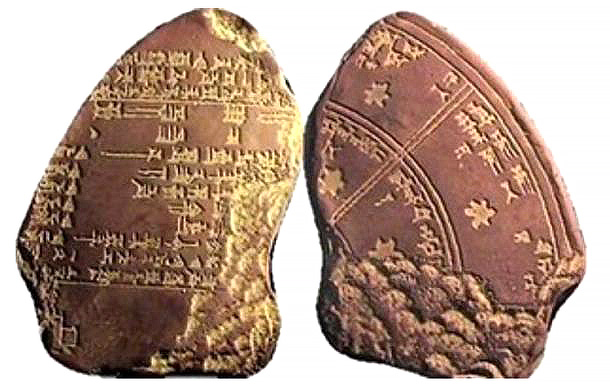 However,
a 1998 review of the subject entitled Babylonian Horoscopes by Francesca Rochberg
re-examined the Babylonian nativities cited by Cyril Fagan decades earlier. As noted in Planet Longitudes in Babylonian
Horoscopes Rochberg found that the Krishnamurthi Ayanamsha tallied most closely with positions
denoted in the Babylonian horoscopes.
However,
a 1998 review of the subject entitled Babylonian Horoscopes by Francesca Rochberg
re-examined the Babylonian nativities cited by Cyril Fagan decades earlier. As noted in Planet Longitudes in Babylonian
Horoscopes Rochberg found that the Krishnamurthi Ayanamsha tallied most closely with positions
denoted in the Babylonian horoscopes.
The Krishnamurthi Ayanamsha is very close to the Lahiri Ayanamsha, differing by a fraction of a degree. According to Lahiri, the Age of Pisces started in 285 AD, while Krishnamurthi gives it at 291 AD. His date is a little closer to 313 AD, when Christianity became the official religion of the Roman Empire.
Most practitioners of Indian astrology find that the Lahiri ayanamsha works nicely with a wide variety of horoscopes, as the examples in this series will demonstrate.
 Charts of famous people make for great reading. As long as the birth data is
accurate, they can be very instructive.
Charts of famous people make for great reading. As long as the birth data is
accurate, they can be very instructive.
When examining our own charts - or those of our clients - it's important that we insist on accurate birth data. Even with accurate information, Astrology can be a challenge. Without it, we're often just wasting our time.
The trick with Astrology lies in figuring out which methods work reliably... and why. If only more people could be born in Germany and Scandinavia, things would be much easier for astrologers ! In those countries, birth data is recorded carefully and accurately: a Seventh Heaven for astrologers.
Here's an interesting case: Shirley Temple. According to the International Movie Database:
If someone were to have shown you her horoscope, would you have predicted great name and fame ? Would you have seen that she was "destined" to appear all over the world, singing, dancing and acting... at the age of 5 ?
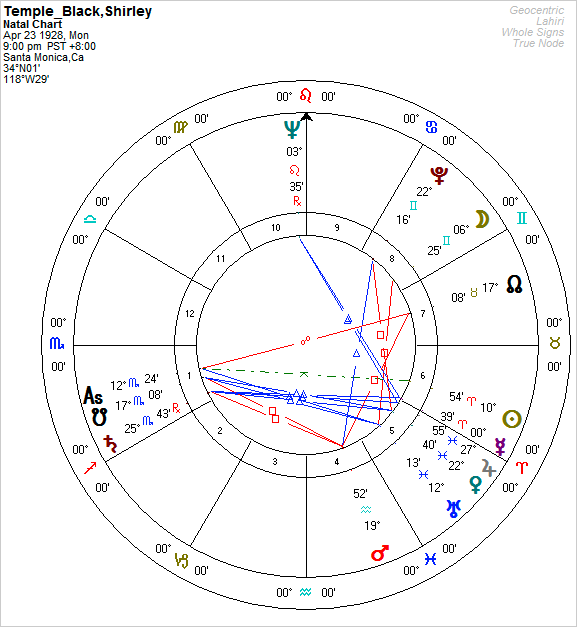
 Venus is in Pisces,
its sign of Exaltation. Jupiter is in its own sign Pisces. We expect Venus to bring great
benefit. It is found in one of the trinal houses (1,5,9),
which by their very nature promote the life of the native. So Venus is strong by Sign and twice-over by
House. As if that were not enough, it is close to Jupiter, the "great benefic". Any planet found next to
Jupiter is strengthened and boosted up. Its affairs get expanded and promoted - especially when Jupiter
itself
is strong, as it is for Ms. Temple: it is in its own sign, Pisces. Venus is, as they say,
"unblemished".
Venus is in Pisces,
its sign of Exaltation. Jupiter is in its own sign Pisces. We expect Venus to bring great
benefit. It is found in one of the trinal houses (1,5,9),
which by their very nature promote the life of the native. So Venus is strong by Sign and twice-over by
House. As if that were not enough, it is close to Jupiter, the "great benefic". Any planet found next to
Jupiter is strengthened and boosted up. Its affairs get expanded and promoted - especially when Jupiter
itself
is strong, as it is for Ms. Temple: it is in its own sign, Pisces. Venus is, as they say,
"unblemished".
It is no exaggeration to say that her 5th house is extremely strong, since it contains two benefics, one exalted, the other in its own sign and the ruler of the 5th house is in the 5th itself. The only aspect to the planets therein is a trine from Saturn. Were it not for this aspect, we would expect many children (5th house), along with fun and fulfillment to reach the heavens.
Indian astrologers like to look at a horoscope from other angles, so to speak, to get deeper insight. After the Ascending degree, the most personal symbol for an individual, is the Moon. So they spin the chart, to place the Moon on the symbolic ascendant, and examine the houses from that perspective.
Remember: traditional Indian astrology is concerned mostly with objective events in the outer world - not with pop psychology - so the houses are the foundation of the entire system.
When we use the Moon as Ascendant (Chandra Lagna), Venus emerges with another strong 5th house connection: it rules Libra, the sign on the cusp of the 12th house, which is 5th from her Moon. That same Venus is in the 10th house from her Moon, so we find the ruler of the 5th house in the 10th house, which suggests a 5th house career influence and a Venusian career influence.
After the Moon, the next most important symbol is the Sun and Indian astrologers examine the Sun chart too. Using the Sun as alternate Ascendant (Surya Lagna), we see that the Sun rules Leo, the 5th house from the Sun and is exalted in Aries. Therefore, the ruler of 5th house from the Sun is exalted... This chart is after all, rather blatant, but wouldn't we expect such a recurring pattern, in the case of such an extraordinary "star" ?
The 5th house is associated with stardom, politics, entertainment, creativity, self-expression and fulfillment. Venus gives charm, grace and beauty. In watery and dreamy Pisces, Venus allures best of all. Pisces is associated with music, poetry, painting, theatre, song and dance, photography and the cinema, escapism, idealism, spirituality, dreams, illusions, trances, as well as oceans, ships and sailors. What else can we expect when we put these factors together ? Performing her signature song Good Ship Lollipop at the age of 6, Shirley Temple had already become a full manifestation of these symbols.
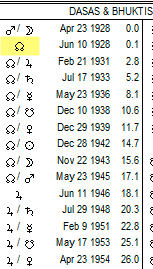 According
to the Vimshottari Dasha system (the 120-year cycle of planetary influences), Shirley
Temple entered the period of Rahu (the North Node of the Moon) not too long after she was born.
This means that the next 18 years would be "under the influence" of Rahu, or Draconis
Caput as it is called in Latin: the head of the dragon or serpent. The North Node is said to
give worldy desires, worldly gratification and worldly
success. In Shirley's case,
the term world is not wrongly chosen: she charmed the world and brought
dreams of
freshness during depths of the Great Depression.
According
to the Vimshottari Dasha system (the 120-year cycle of planetary influences), Shirley
Temple entered the period of Rahu (the North Node of the Moon) not too long after she was born.
This means that the next 18 years would be "under the influence" of Rahu, or Draconis
Caput as it is called in Latin: the head of the dragon or serpent. The North Node is said to
give worldy desires, worldly gratification and worldly
success. In Shirley's case,
the term world is not wrongly chosen: she charmed the world and brought
dreams of
freshness during depths of the Great Depression.
At the time of Ms. Temple's birth, Rahu, which normally moves backwards with respect to the planets, was stationary. When a planet or symbol is stationary at birth, its effect is strengthened. Her North Node is also in Taurus, the sign or constellation in which it is said to be most powerful. For Rahu, Taurus is the sign of Exaltation. In addition, it is placed in one of the angular houses, (1,4,7,10) where it is even further strengthened. So an astrologer could see that in this chart, the North Node is so strongly disposed, that during its period, it should bring a fair measure of name, fame, wealth, or other "materialistic" rewards.
If we look further, we note that the dispositor of Rahu is Venus: Rahu is in Taurus, and Taurus' ruler is Venus - the same benefic planet which we just described as being a great influence in her chart. Since the nodes generally give the results of their dispositors, an observant astrologer would predict that BIG things would happen early in life - as soon as Rahu Dasha started. In Shirley's case, the theory is born out by the facts: in the middle of the Rahu period, she could, in the words of the biographer above, "do it all".
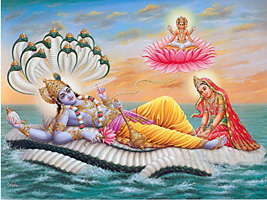 In Indian mythology, the Supreme is
sometimes depicted as Vishnu ("the pervader"), reclining on
the coiled serpent Ananta ("with no end"), floating atop an ocean of milk. From his navel, the
dream of creation is manifest, rendered here as a lotus which opens and closes, with Brahma
the Creator inside.
In Indian mythology, the Supreme is
sometimes depicted as Vishnu ("the pervader"), reclining on
the coiled serpent Ananta ("with no end"), floating atop an ocean of milk. From his navel, the
dream of creation is manifest, rendered here as a lotus which opens and closes, with Brahma
the Creator inside.
With each opening of the lotus, Brahma ("the filler") projects the Universe of Matter, which from our perspective endures over countless aeons of time. When the lotus closes, the cosmic dream is dissolved. Time and Space come to an end. Each time the lotus opens and closes, a new Universe waxes and wanes.
 The symbolic "Ocean of Milk" may refer to the night sky,
with each "lotus" a spiral galaxy, like our own Milky Way, whose center is in the other Jupiter-ruled
sign, Sagittarius. Thus, Vishnu may relate to the Jupiter force, the great benefic, the principle of
expansion. His
consort Lakshmi, (literally "aim"" or "goal" - that which is to be regarded), relates to the other
benefic, Venus.
Symbolically rendered as a devoted Indian spouse, she massages Vishnu's feet (Pisces, rules by
Jupiter) while he dreams (Pisces)
the cosmic dream.
The symbolic "Ocean of Milk" may refer to the night sky,
with each "lotus" a spiral galaxy, like our own Milky Way, whose center is in the other Jupiter-ruled
sign, Sagittarius. Thus, Vishnu may relate to the Jupiter force, the great benefic, the principle of
expansion. His
consort Lakshmi, (literally "aim"" or "goal" - that which is to be regarded), relates to the other
benefic, Venus.
Symbolically rendered as a devoted Indian spouse, she massages Vishnu's feet (Pisces, rules by
Jupiter) while he dreams (Pisces)
the cosmic dream.
On a deeper level, this image may depict the blissful cooperation between the two benefic forces, which give rise to the sweet dream of Life, however transitory it may be. If Time is indeed an illusion, but a persistent one as Mr. Einstein suggests, then it persists because, as the poet William Blake has written:
 Interested in the horoscopes of other cinema stars ?
Interested in the horoscopes of other cinema stars ?
See these articles:
 Want to learn more about Astrology ?
Want to learn more about Astrology ?
See these authors: